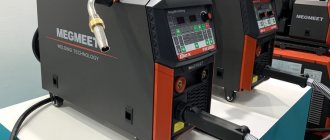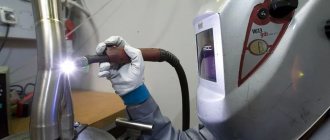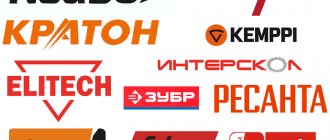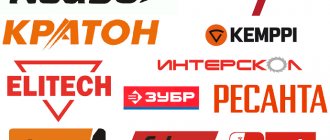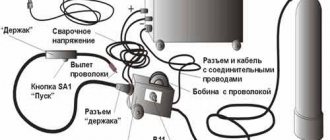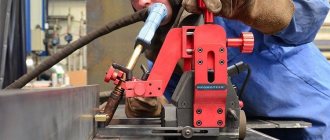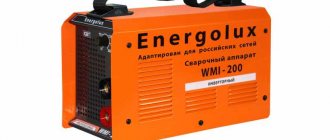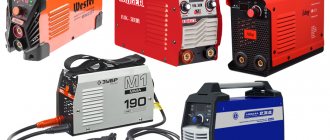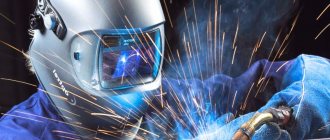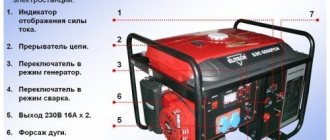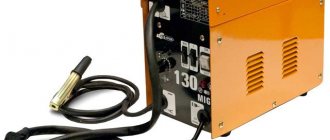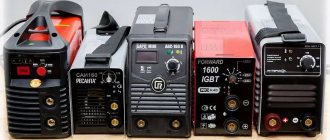The welding machine, characterized by its small dimensions and low weight, is an indispensable thing for a master working on a private contract or at sufficient heights. Inverters of this type are also widely used among home craftsmen. Most experts agree that a miniature welding machine, due to its small size, is the best type of mobile inverter in the modern world. So, with all its modest functional capabilities, it is still capable of performing most essential tasks, and the ability to easily transport it makes work much more convenient.
Mini welding system - general information
In fact, in professional terminology, as such, the concept of the “mini” prefix does not exist - it is a simple manifestation of “folk” love for the instrument in question. Correctly, “mini welding machines” should be called “compact inverters”. However, this class of equipment has gained quite popularity recently due to the trend towards reducing the size of any construction and installation equipment in order to increase its mobility. Nevertheless, even small devices according to their functionality can be divided into:
- Household;
- Professional;
- Industrial.
The “mini” prefix can be applied to any welding machine in which most of the parts are, so to speak, “packed” directly into the main body and which has rather modest functional characteristics.
IMPORTANT! A mini-device is not necessarily always low-powered - it can have good power, but be capable of performing a very narrow range of operations.
As a rule, a small unit for welding work is called an arc welding machine with a weight of 2 kilograms and a power of 150 amperes.
Advantages of mini models
A small welder has many advantages. The main ones are its size and weight. With these reduced indicators, there are simply no problems with transportation and storage. If an amateur craftsman often has to use it in the summer season at a summer cottage, then transporting/bringing the installation will not be difficult, and storage in the winter can be done in an apartment/garage. Moreover, the unit will not take up much space both during storage and transportation.
In addition, miniature welding equipment does not experience connection problems. For work, it is quite possible to use a standard 220 V socket (even in an electric generator) and weld. Operation is also possible during voltage surges, because the equipment does not require powerful power, because consumes little electricity.
Despite its compact size, the device will be quite functional and will be able to smoothly regulate the current strength and maintain stability when the arc burns. It is worth noting that, unlike bulky construction models, miniature options do not require special handling and operation skills.
Disadvantages of mini models
The main disadvantage of mini welding machines is their lack of ability to work with electrodes whose diameter exceeds 3 millimeters. Moreover, most standard mini-models will hardly be able to support an arc even on a 3 mm electrode. From here it is clear that a certain range of work that requires only thick electrodes is simply beyond the capabilities of small devices.
The next disadvantage may be the modest technical parameters. Even if it says “220 Amps” on the case, the mini-inverter will rarely support more than 150 Amps. Separately, it is necessary to mention that if the electricity supply is unstable, then this parameter will be even lower.
Due to the fact that the equipment in question has a compact body, you cannot count on a full-fledged cooling system in the device. Hence the conclusion - intensive work for a long time is impossible due to the risks of overheating the unit and causing it to break. However, this difficulty can be solved by taking frequent breaks in the work process.
In addition, due to their compact size, mini-units are not equipped with anti-stick or afterburner systems, which will create additional inconvenience during the welding process.
Application areas of mini welding machines
Due to their affordability, compactness and lightness, mini welding machines are actively used in the domestic sphere: to weld a fence at the dacha, make a barbecue, run a water pipe to the garden, weld a crack between a hinge and a gate post, put up a gazebo or greenhouse.
More experienced craftsmen can use it to make a container for a summer shower or for fuel. It is convenient to work with such models on the shoulder, so installing a long fence or mounting an antenna on the roof does not require the involvement of assistants - the welder moves with the inverter himself and his hands are free to hold the workpieces.
But this is an exclusively household class of goods, designed to work several times a month. It is not suitable for a small workshop or commercial activity and will quickly burn out under stress. In addition, welding capabilities are limited to a thickness of 3-8 mm and are not suitable for critical structures.
Features and operating rules
A miniature inverter, although by and large similar to its “large” counterparts in design, will be very different from them in terms of its use. First of all, we mean the tendency of small units to overheat. Also, they are poorly resistant to changes in ambient temperature coupled with changes in humidity; dust can very easily clog in them (which is a consequence of the lack of special protection, which was done, again, for the sake of small dimensions). For all the above reasons, it will require special attention.
Mini models should not be used in direct sunlight or during periods of precipitation. Storing them outside the box is unacceptable (it is recommended to use at least a protective film). Long-term storage should occur only at room temperature; sub-zero temperatures are unacceptable. Working at maximum current for more than 5 minutes without a break is prohibited. The diameter of the electrode used should not exceed 3 millimeters (recommended thickness is 2 millimeters). During operation, it is necessary to constantly monitor the condition of the case - it should not overheat. For welding you need to use only high-quality electrodes and cables. If the device begins to make extraneous sounds or even starts to smoke, work must be stopped immediately by turning off the power to the device. And finally, small-sized units should not be used for complex work - for example, they will never cope with welding thick iron in difficult environmental conditions.
Also, in order to extend the service life of the unit, it is advisable to follow a few simple rules:
- It is recommended to store the mini-welding system in its original packaging in a heated room (up to +55 degrees Celsius) with natural ventilation;
- If the storage temperature was from 0 to +5 degrees Celsius, then before the first start it is necessary to allow the system to “settle” at normal room temperature for at least 2 hours;
- Before starting work, it is necessary to check all components and connections of the unit - detected traces of oxidation must be cleaned, and loose connections must be tightened;
- Do not allow drops of moisture, as well as dust and dirt, to enter the system housing - all this will disrupt heat transfer and cause overheating of the motor;
- It is required to regularly inspect electrical wiring and cables for their integrity;
- When working with the device, you must follow safety precautions, use protective gloves and a mask with light filters.
Comparison table of characteristics
The summary table contains the main parameters.
| Name | Dimensions, cm | Diameter of electrodes, mm | Power consumption, W | Weight, kg |
| CALIBER, MINI SVI-180AP | 27.2x16.0x19.2 | from 1.6 to 3.2 | 3800 | 2,93 |
| Edon, MINI-250S | 23 x10 x14 | from 1.6 to 4.0 | 4700 | 2,6 |
| Wester, MINI 200T | 40 x 20 x 26 | from 1.6 to 5 | 8200 | 4 |
| KVAZARRUS 190 mini | 23.5 x 9.8x14.6 | from 1.6 to 4 | 6600 | 3,5 |
| Varteg 190 mini | 23.6x9.8x14.6 | from 1.5 to 4 | 6600 | 2,5 |
| SPEC, Mini-210 | 29x19x20 | from 1.6 to 4 | 4500 | 2,5 |
| CHAMPION, IW-160/7.2A mini | 24.5x10x15 | from 2 to 4 | 5200 | 2,8 |
| Wester, MINI 160T | 40x20x26 | from 1.6 to 4 | 6600 | 3 |
Design and principle of operation of a mini-inverter
In appearance, it resembles an ordinary box, inside of which is contained the simplest electronic inverter circuit. It weighs little and can easily be moved from place to place. Most small models are equipped with a special carrying strap, which is very convenient for using the device in high-altitude production conditions.
Its design (in most cases) consists of:
- Radiator for output bridge rectifier;
- Radiator for transistors and diodes;
- Network rectifier;
- Relay for soft start;
- Welding current sensor;
- Integral stabilizer;
- Noise suppression filter and its capacitor.
The units under consideration transform electricity during operation, changing its characteristics four times before creating current. It will be equal to several tens (at best, a couple of hundred) Amperes. This is the direct principle of operation. Small-sized inverters are used to connect various metal objects into one using a welding arc. The current from the arc hits the metal through special electrodes, heating it. The metal on the objects melts, thereby producing their adhesion.
The main difference between a mini-device and a classic welding machine is that the former is capable of working with high-frequency current. The resulting magnetic induction allows you to reduce the 220 Volts entering the system down to 30 Volts. In this regard, it becomes possible to obtain an input power of one and a half to two hundred Amperes. This kind of force will help you work with metal with a stable and stable arc. The arc will be able to melt and join the metal into a weld properly. Among other things, working with a small-sized model does not require special skills - the main thing is to follow safety precautions.
More precisely, the technical stages of operation of a miniature welding machine will have the following sequence:
- Voltage equalization;
- Smoothing it using a special filter;
- Transformation of direct current into high-frequency alternating current;
- Reducing voltage while increasing current;
- Current equalization.
Types of units
All products produced by manufacturers are divided into certain types, based on the welding method and the current source. The usual network voltage of 220 V and 6 - 32 A is not suitable for such work. It needs to be transformed. For this purpose, the following types of equipment are produced:
| Kinds | Description |
| Inverters | Equipment that consumes alternating current of 50 Hz from the network and converts it to 100 Hz. In this case, the voltage is rectified twice. Welding is carried out at a direct current of 30 to 300 A with a voltage of 50 - 80 V. The seams are smooth and the penetration is deep. There is virtually no metal spattering. The design diagram of inverter type includes: • step-down transformer; • diode bridges; • board with keys; • second transformer; • transistors. The product is compact, quiet in operation and lightweight. Inverters are divided into the following subgroups based on the type of transistor: • Mosfet (budget option, weigh a lot, are reliable, have a free layout, large parts and maintainability); • IGBT (modern models installed in premium welding machines). |
| Transformers | Inexpensive units. They include two windings: primary and secondary. The operating principle is magnetic induction. Welding occurs under alternating voltage. Able to join ferrous metals. They are distinguished by reliability and ease of operation. They weigh a lot, they buzz loudly, the dimensions are impressive, and the metal splashes a lot. |
| Rectifiers | Affordable welding machines. Create a high-quality seam. It operates from a 220 V network, lowering it to a value of 40 - 80 V, while increasing the current to 200 - 400 A. The products differ in power. The structures are equipped with starting and protection elements. The devices are reliable and wear-resistant. They serve faithfully for a long time. Scope of application - in everyday life and at work. Welds ferrous and non-ferrous metals, as well as cast iron. Disadvantages include large size and significant weight. |
Based on the type of welding, structures are divided into the following categories:
- Semi-automatic MIG/MAG welding. A torch is used to make the seam. The metal connection occurs through an electric arc. Continuous supply of additive allows you to make neat seams. Works with metal thickness from 0.6 to 20 mm. Connects stainless steel, ferrous metal and aluminum. You do not need to carry a cylinder with you. Inconvenient to use outdoors. Gusts of wind can blow out the gas.
- Gas welding. We are talking about an acetylene generator that produces gas from carbide and water. It is necessary to have an additional oxygen cylinder, which helps to reach temperatures of up to 3000 degrees. The method is often used for welding containers and pipes up to 4 mm thick. No electricity is needed to operate. You can use the unit far from civilization. Welding speed is low. Significant heating may cause the structure to become deformed.
- Manual arc welding MMA. Such products are manufactured on the basis of rectifiers, transformers and inverters. In the hands of the welder there is a holder with a melting electrode. The arc is closed by a metal rod and is a filler material. Allows you to connect ferrous metal. When installing electrodes equipped with a stainless steel rod, alloy steel can be connected. For a quality connection you will need experience in this matter. Manipulations occur slowly, and you have to constantly monitor the arc as the electrode becomes smaller.
- Argon arc welding TIG. Inverters are used for welding. The connection occurs using an electric arc. Able to weld elements made of stainless steel or ferrous metals.
- Spot welding. Available for single-sided and double-sided welding. In the first version there is a pistol with a reverse hammer, in the second - pliers. The scope of application of the products is the assembly of gates, gates, boxes, body repair. Manual models weigh up to 16 kg and can be moved from place to place. On the market you can find stationary machines for resistance welding. In this case, the thickness of the metal sheets being connected can vary in the range from 3 to 9 mm.
- Universal. According to buyers, the best. They include several modes: MIG+TIG, MIG+MMA, TIG+MMA, three in one.
- Plasma welding. The main component is an electric arc that burns in the nozzle between the anode and cathode. It passes air from the compressor, forming plasma. When using filler wire, the method can be used for welding products.
Household use as the main area of application of mini welding machines
Despite the fact that mini-units are divided into both industrial and professional, they have the same properties as household ones - almost identical amperage and the impossibility of long-term operation without overheating. Household options, most often, are not equipped with special regulators for working with unstable voltage, so it is better to purchase such a device separately in order to be able to select the current strength for the comfortable welding mode. Household appliances are rarely able to work for more than 30 minutes at a time without overheating, even at low voltage. It’s always worth remembering that the smaller the amateur model, the less functionality it has. However, low functionality also means low energy consumption (the savings are obvious) and even with low consumption, the mini-version will be able to make a strong and even seam and work in argon arc welding.
The undoubted advantage of household equipment will be its relatively low price, but its body is poorly resistant to mechanical stress. Therefore, it is undesirable to drop a household inverter, even from a small height, and even more so it must be protected from various impacts. The absence of a dust and moisture protection system will require periodic maintenance of welding equipment.
Tips for choosing
Before choosing a tool, you need to decide on the list of tasks, the thickness and types of metals that will need to be welded. Parameters requiring attention:
- Power. The maximum current that the device produces. The thickness of the metal being welded and the diameter of the electrode depend on it. 200-250A is enough.
- Minimum operating voltage. In villages and summer cottages there are weak transmission lines, so the voltage drops in the network. Working through an extension cord also causes a voltage drop. The recommended parameter is 140-260V so that the device can work.
- Welding current range. Affects the diameter of the electrodes used and the thickness of the metal available for welding. For a 3 mm electrode, a current of 90-110A is required. It is better to take it with a reserve - 160 A.
- Length of cable. Working at a table - 1.2-1.5 m is enough. Usually this length corresponds to the standard configuration. If you cook in other places, you need to purchase another wire.
- Duration or period of switching on, load duration. Indicated as a percentage. These parameters determine the operating time without interruption. If 30% is indicated, then 3 minutes work, 7 minutes break.
- Open circuit voltage. Affects the ignition speed and stability of the electric arc. The higher this parameter, the better.
- Additional functions. Hot-start - hot start, facilitates and speeds up the ignition of the arc. Arc-Force - forcing the arc, the device itself increases the current strength to strengthen the arc and prevents sticking. Anti-Sticking – protection against sticking, strength decreases after a certain time.
- Manufacturer. A well-known brand that has proven itself in the market. Availability of spare parts in case of failure.
- Service center. If the seller company has its own, then this will be the best recommendation. It is not profitable to sell devices of poor quality - you will have to repair them.
- Reviews. Popular models usually have many recommendations from buyers. You need to pay attention to those posted recently. Product quality may vary. Sales managers usually know information on returns from customers.
Mini welding machines are a convenient tool for periodic work. The model is selected according to the parameters of the metal that needs to be welded and the parameters of the electrical network.
Self-production
Often, in the household you can find a lot of spare parts from household appliances that have become unusable (TVs, microwaves, electric kettles, etc.), which can be used to independently manufacture a household mini-welding system.
Manufacturing a spot welding device
This is the simplest way and will require:
- Low-power transformer;
- Diode bridge;
- Capacitor bank;
- Automatic 20 Amp;
- Current relay (powerful);
- A pair of copper rods (tips from soldering irons are perfect).
First, the secondary winding is removed from the transformer, and three turns of welding wire are wound in its place. Next, the secondary winding is connected to a diode rectifier, and its output is connected to a bank of capacitors connected in parallel. The output of the capacitors, via a relay, is connected to copper electrodes. Then, the welding itself is carried out in two steps. The first step is to charge the capacitor bank. At the second step, the objects to be welded are aligned, the electrodes are pressed against them in the right place, the relay is switched, resulting in a discharge of the accumulated electricity. During discharge, a large current arises, which melts the metal at the point of pressure. As the molten metal cools, the objects adhere securely.
Difficulty of choice
In order not to make a mistake when choosing a miniature welding system, you should listen to a few simple tips from professionals:
- Before purchasing, it is advisable to find out exactly the voltage at which you will most often have to use the device - based on this information, you will need to select its power. If you often have to work with unstable voltage, then it is better to choose equipment with high power. If the voltage is stable, then both a medium and low-power device will do.
- You should analyze the potential average duration of future welding work in order to immediately determine the need to purchase an additional remote cooling system.
- You need to consider the type of metal objects that will have to be welded. If you have to work on cast iron, you will need a powerful device, but for copper and stainless steel, medium power will do;
- It is necessary to decide on the set of functions - as a rule, branded devices have a wider range of options, but their prices are very high.
How to choose the right model for home use
Which product is best to buy depends on many factors, including the purpose and frequency of use. Small devices are suitable for jewelers. To install a fence or gazebo, you will need more powerful devices. Everyone's selection criteria are different. Some choose which company has the best product, others pay attention to functionality, others are interested in what it costs, and others believe that the best option is new products from the best manufacturers.
Experts advise when purchasing to pay attention to the following product parameters:
- power;
- type of welding;
- dimensions;
- area of use.
If you plan to use the device at the household level, then it is better to give preference to portable or small-sized welding machines. Mini-equipment has low power and is convenient to store and transport. The scheme of work is elementary.
Single-phase and two-phase models are available on sale. Which one to choose depends on many factors. Before making a final decision, it is worth consulting with an experienced sales manager. The focus is on power and individual needs.
The opinion that everything Chinese is bad is not correct. It was like that before. Today, a large number of high-quality products are produced on the territory of the Middle Kingdom, which in terms of characteristics and functionality are not inferior to their European counterparts. Only the price is more reasonable.
You can't lose sight of the material used. It must be reliable, wear-resistant, high quality, durable and have a long service life. In order not to overpay for a product, you need to decide on the scope of its application. Additional options may not be needed in everyday life.
Where to buy welding equipment? You can visit a specialized retail outlet, get acquainted with the offered assortment, and choose the right products from the abundance. If in doubt, you can talk to a professional salesperson.
There is another purchasing option - order the product online in an online store. This is a risky move. Much depends on the supplier and his integrity. Instead of expensive products from a well-known world brand, you can get a cheap Chinese counterfeit.
conclusions
In addition to the brands presented in the rating, I would like to dwell separately on such brands as RofHelper from Italy and Brima from Germany. By purchasing equipment from these companies, you can be confident in 99.9% of cases in the quality, sufficient functionality and durability of welding systems. However, you should not neglect devices equipped with their own liquid fuel engines. They will be an ideal solution for working in difficult natural conditions, and even more so at heights. In any case, it is always worth remembering that by sacrificing the full functionality of the mini welding system, the user gains a high degree of mobility of welding work.
